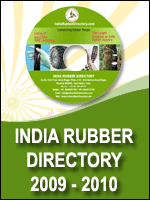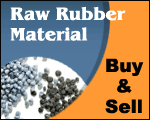Heat Shrinkable
Polymer blends Based on Ethylene Vinylacetate
(EVA) and Polyacrylic Rubber (AR-31)
S. Raychodhury, B.B. Khatua, M. Maity and C.K.Das
Materials Science Centre, I
IT, Kharagpur, India
Abstract
From the technological point of view the use the use of polymer blends and
composites is very important. There is very little information regarding heat
shrinkability of polymer blends. Here efforts have been put forward to develop
blends based on EVA and AR-31 which are having considerable shrinkability. High
elongation of EVA have led its use for the property concerned. It is observed
that with increase in sure time and elastomer content the shrinkability of the
blends increase H-T sample get an edge over R-T counterpart so far as
shrinkability is concerned. Thermal studies like YGA/DTA will corroborate the
higher stability of these polymer blends. Through XRD we have studied the change
of crystallinity of polymer blends with increase in elastomer content and the
cure time. These blends find their use in cable insulation as encapsultant and
also in the field of telecommunication applications
Introduction
Because of their growing industrial importance polymer blends have become an
important area of research. The blends prepared by meltimixing of elastomer and
thermoplastic materials have gained appreciable attention {1,2} now-days. The
incorporation of crosslinking agents improves the mechanical properties of the
blends {3,4}. There is very few published systematic information concerning the
shrinkability of elastomer blends. The use of plastic EVA in blends has an
importance from the technological point of view. AR-31 shows excellent
properties in terms of ozone resistance, high temperature (H-T) resistance.
Recently Das et al. [5] have studied the heat shrinkability and flame resistance
of some thermoplastic/elastomer blends. This paper correlate shrinkability with
various processing parameters.
Experiment
The blends of EVA/AR-31 were prepared by gradual replacement of EVA by AR-31;
-EVA/RA-31 = 90:10, 70:30, 60:40 and 40:60 in brabender plasticorder (PLE-30)
for 7 min. at 20 rpm. The temperature of mixing was 1100 C, the curative system
used is Pb3O4 (2 ph. The temperature of mixing was 1100 C, the curative system
used is Pb3O4 (2 phr, based on elastomer), CBS (2 phr), S (1 phr). The blends
prepared were taken to be cured in a mould in hot press at 1500 C, 4 T pressure
for 10,15,20,25,30 min. BY this operation the rubber phase crosslinks but platic
phase remains as it is. Lengthwise shrinkage was studied and under three
different conditions shrinkage was measured.
(a) The vulcanizates were given elongation at ambient, then the shrinkage of the
elongated sample was measured at 1500 C.
(b) The vulcanizates were elongated at 1200 C and 1500 C and shrinkage was
measured at 1500 C.
Shrinkage (%) was measured as per formula given below:
Sh (%) = Lstr-Ls
Sh (%) = % shrinkage; Lstr = length of the sample after stretching;
Ls = length of the sample after it has relaxed.
Differential thermal analysis (DTA) and thermogravimetric analysis (TGA) were
conduced using Shimadzu Thermal Analyser (DT-40) in air at a rate of 100 C/min
within the temperature range of 25-6000 C. X-ray Diffractometer with cobalt
target (CoK) at a speed of 0.050 2/sec chart speed 10 mm/2, CPS 5000 c/s and
a slit of 0.2 mm applying 40 KV,20 mA current to get the idea of crystallinity
of the thermoplastic as affected by the elastomer.
Results and Discussion
A. Effect of Cure Time and Elastomer Content on Shrinkability
The variation of shrinkability of the blends with cure time at constant
elastomer content (EVA/AR-31 90:10) for both the higher temperature (H-T)
stretched and Room Temperature (R-T) stretched sample are shown in Fig.1. The
figure showsthat the shrinkability of the blends increase with cure time in case
of all blends. H-T stretching shows higher shrinkability followed by R-T
stretched samples, at 10 min cure time only is the exception. This may be
because of the crosslinking of the elastomer. More the cure time more is the
extent of crosslinking. In case of H-T stretching samples shrinkability is
higher than that of R-T stretching samples. It may be due to the large extent of
crosslinking of the former as it is kept in higher temperature for longer period
of time.
The variation of shrinkability with elastomer content at constant cure time is
shown in Fig.2. It is obvious from the figure that at constant cure time the
increase of elastomer content increases the shrinkability of the blends for both
R-T and H-T stretched samples. H-T shrinkability is getting edge R-T increase in
shrinkability may be attributed to the increased elastomeric phase which is
crosslinked. From the figure it is seen that for 10 min cure time the value of
shrinkability in case of H-T stretched sample is lower than that of R-T
stretched
Sample and also from figure 2 it is clear that for constant cure time the
shrinkage value H-T stretched sample with 10% wt elastomer is lower than that of
R-T stretched sample with equal composition. This anamoly may be because of
lesser amount of elastomer and lower extent of crosslinking which is obtained in
10 min and also in case of H-T stretched sample the extent of stretching is
higher than that for R-T stretched sample. Actually this feebleness of elastomer
arises due to its inability to bring back the polymer blends in its normal
positions. The inability is due to its smaller amount and lower extent of
crosslinking.
B. Effect of Crosslinking on Stability of Polymer Blends
It is found from the TGA and DTA that the stability of polymer blends with
constant elastomer content increases with increase in cure time. For 10%
elastomer content the degradation temperature increases, with cure time.
Degradation starts from 3400C, 3500C and 3600C for cure time 10 min, 15 min and
30 min respectively.
C. Effect of Cure Time and Elastomer Content on Crystallinity
Crystallinity is measured by X-ray diffraction. With increase in cure time
10 min to 20 min for a blend with fixed composition, the crystallinity
increases, again from 20-30 mins the crystallinity of theblends decreases. But
for the case of blend with higher elastomer content the crystallinity decreases
slightly, in comparison with the blends cured in same time and of different
composition. These can be explained in this way-for fixed elastomer content
blend the crystallinity increases from 10 min to 20 min cure time, because
elastomer phase gets crosslinked in higher extent. But from 20 min to30 min the
crystallinity decreases, due to the higher extent crosslinking the orderness of
EVA may be disturbed and consequently crystallinity goes down. But in case of
higher elastomer content, cure time, remaining the same, due to greater effect
of elastomer present orderness may be disturbed and crystallinity may decreases.
Conclusion
With increase in cure time and elastomer content shrinkability of blends
increases both in case of H-T stretching and R-T stretching. H-T stretching
sample generally shows higher shrinkability then R-T stretching sample. Thermal
stability increasing in cure time of the blend. Cure time and elastomer content
have profound effect on crystallinity.
References
1. Waler, B.M. (1979). Hand Book of Thermoplastic Elastomers, Van Nostrand
Reinhold, New York.
2. Wheler, A and Lee, K.S. (1982). Developments in Rubber Technology
Thermoplastic Rubbers, Applied Science, London.
3. Campbell, D.S., Elliot, D.J. and Wheelans, M.A (1978). NR Technol, 9, 21
4. Coran, A.Y and Pelet, R.P. (1980). Rubber Chem. Technol., 53, 781.
5. Patra, P.K. and Das, C.K. (1997). Intern. J. Polymeric Mater, 35, pp.
103-118.


























